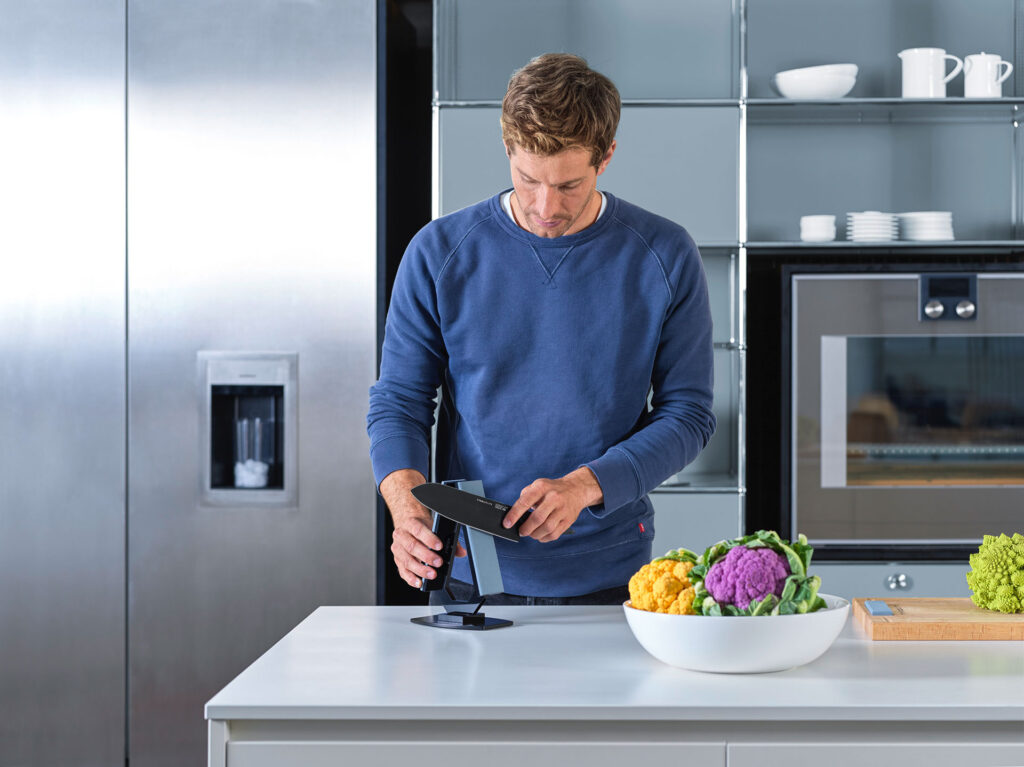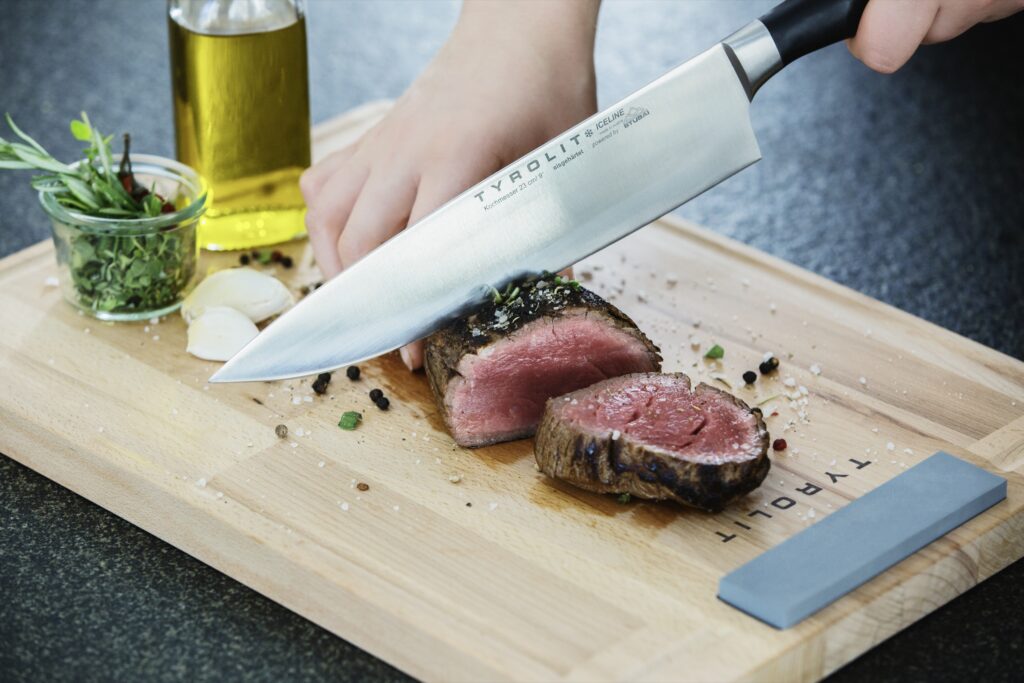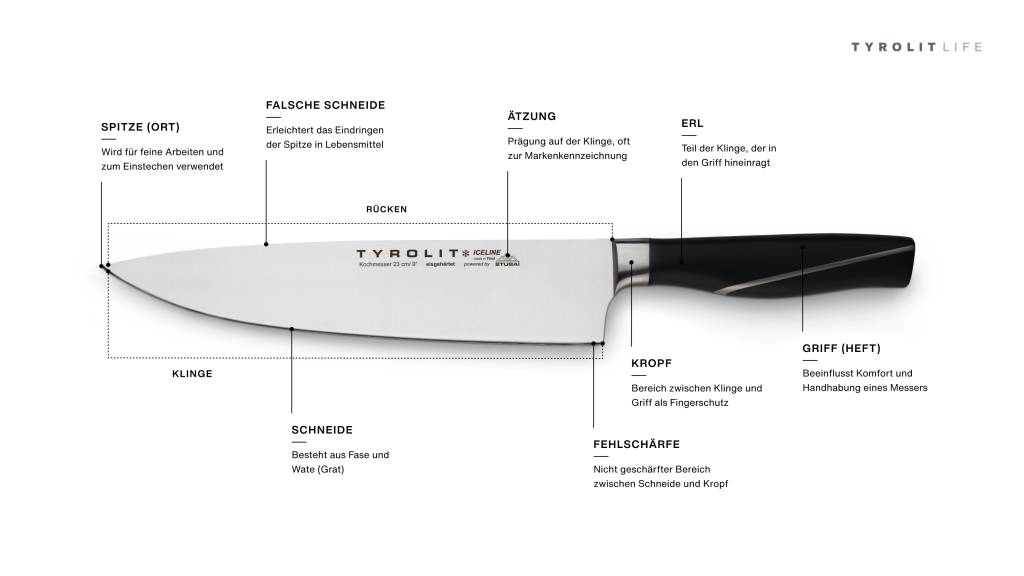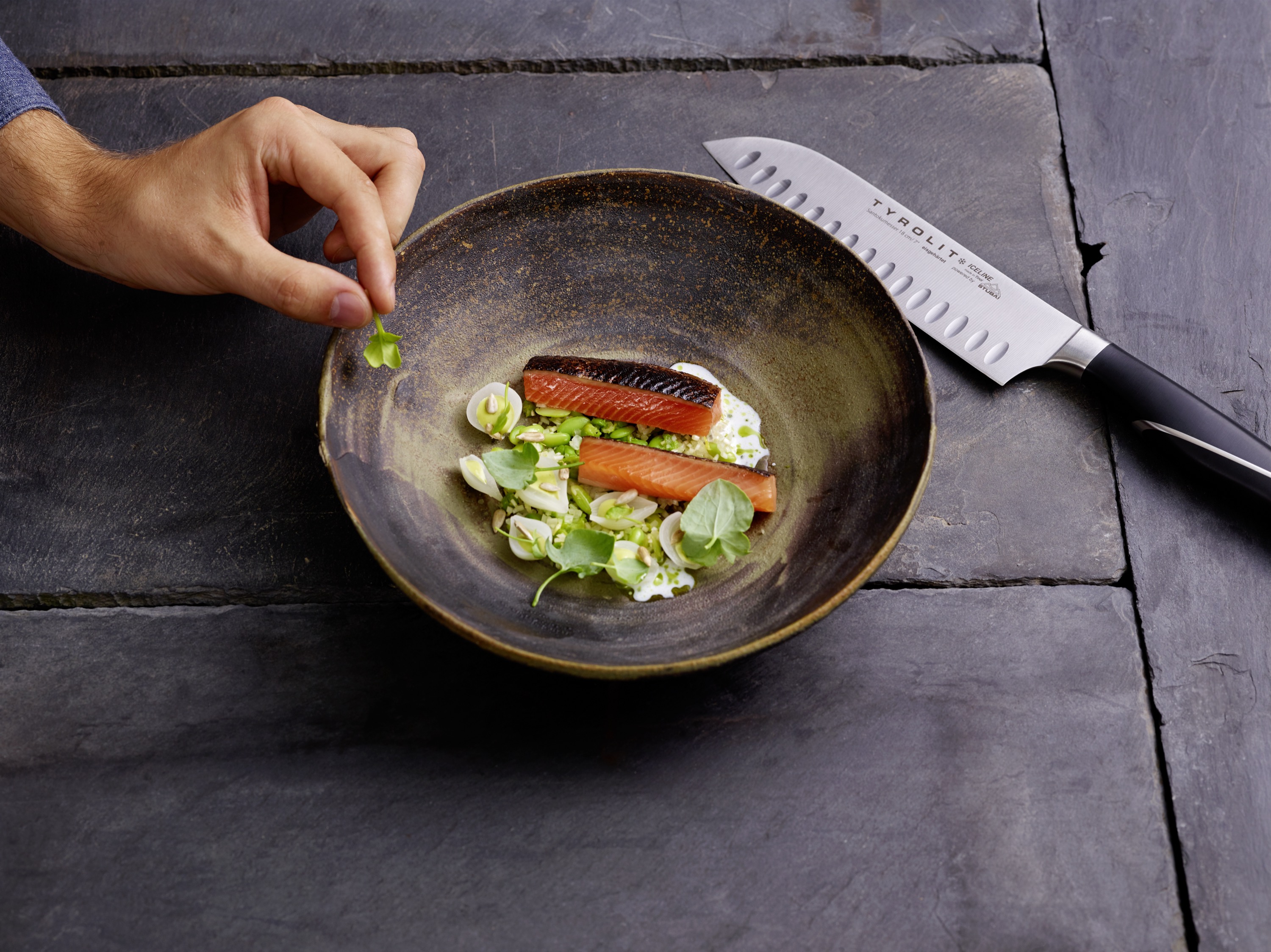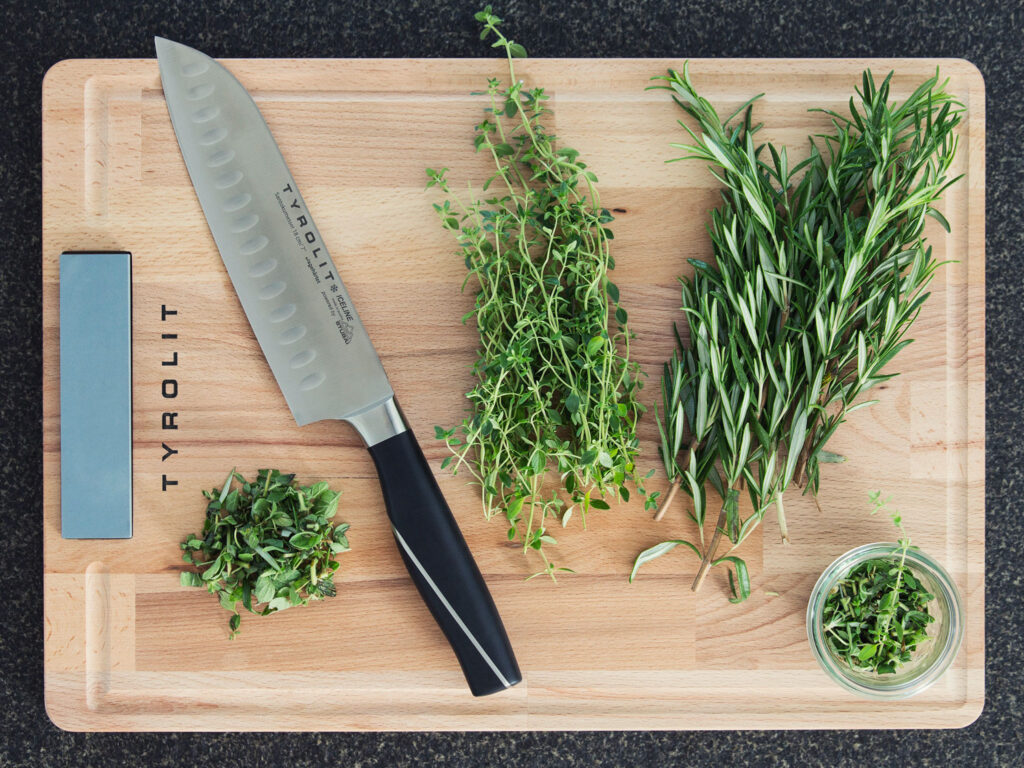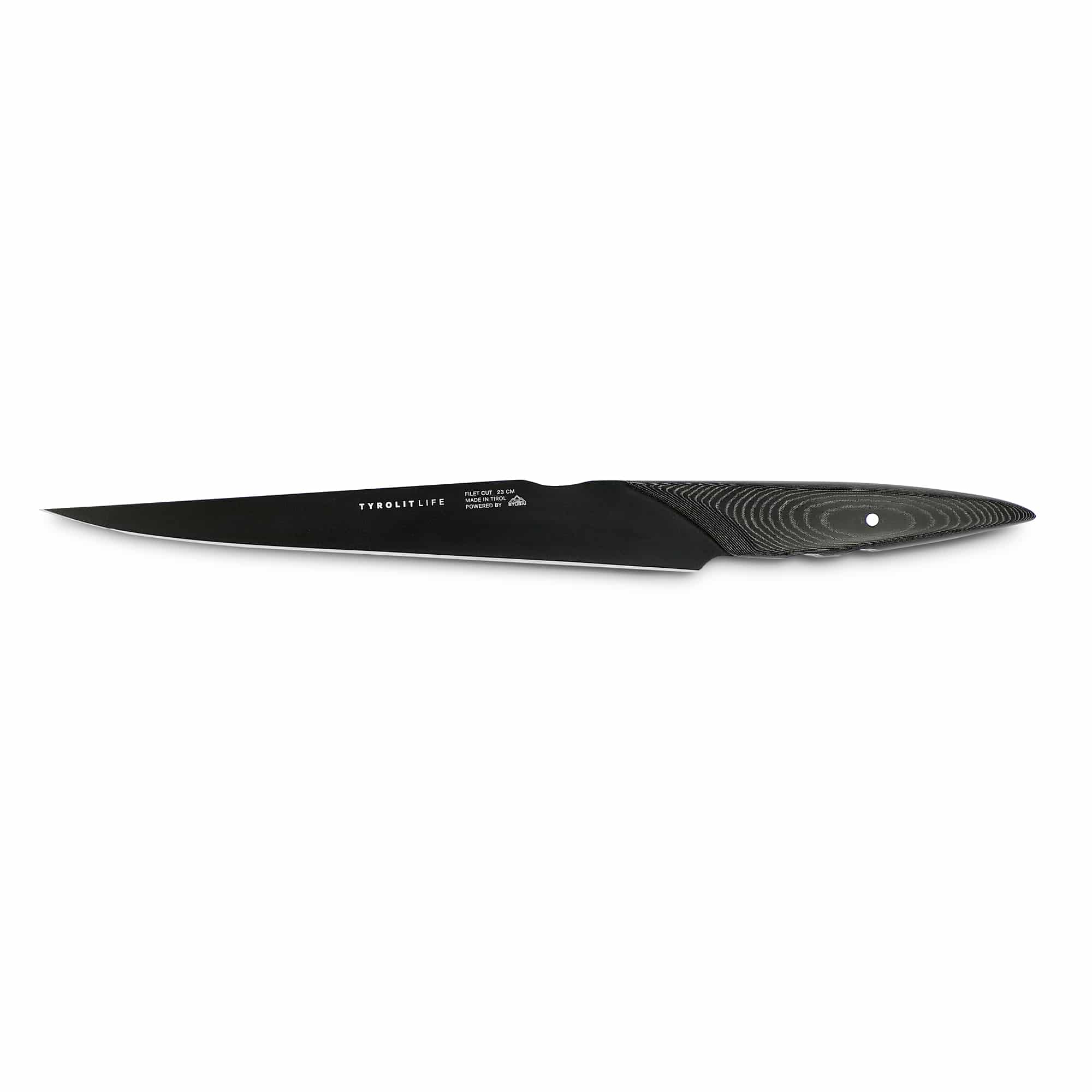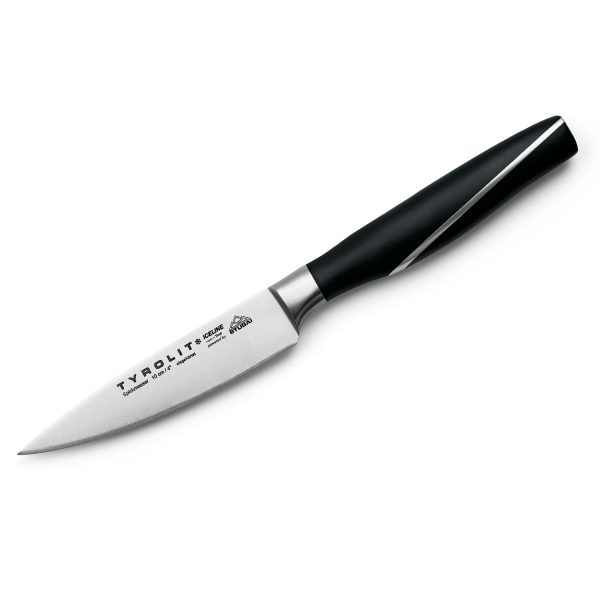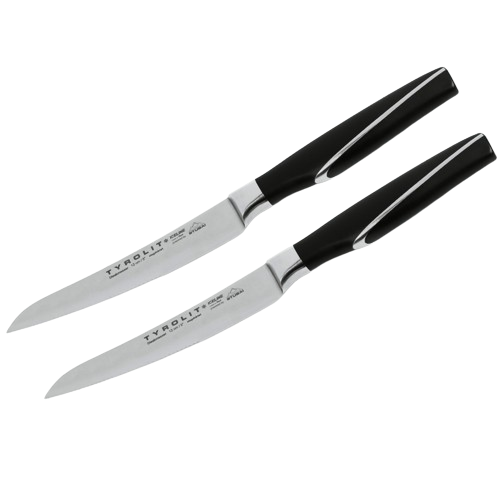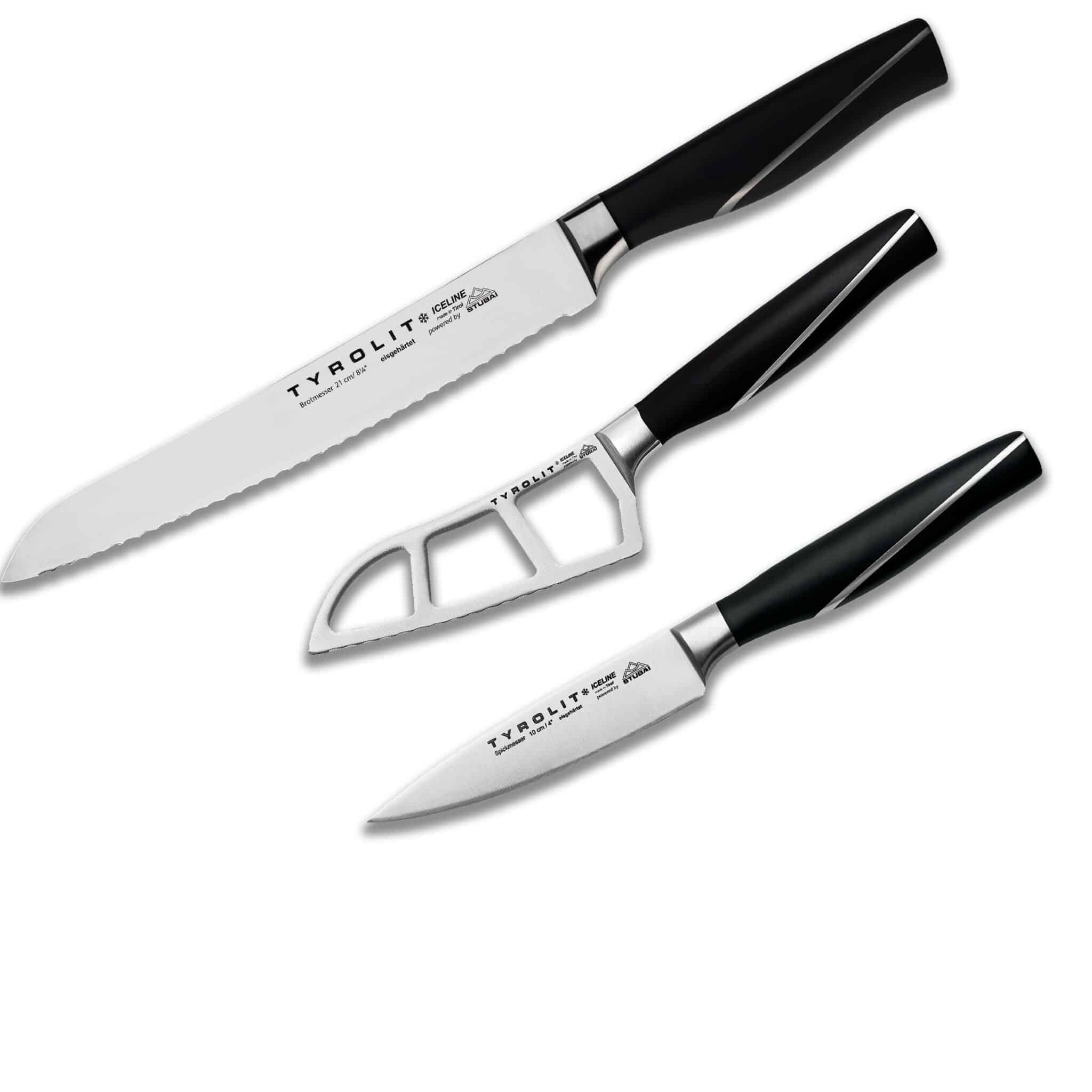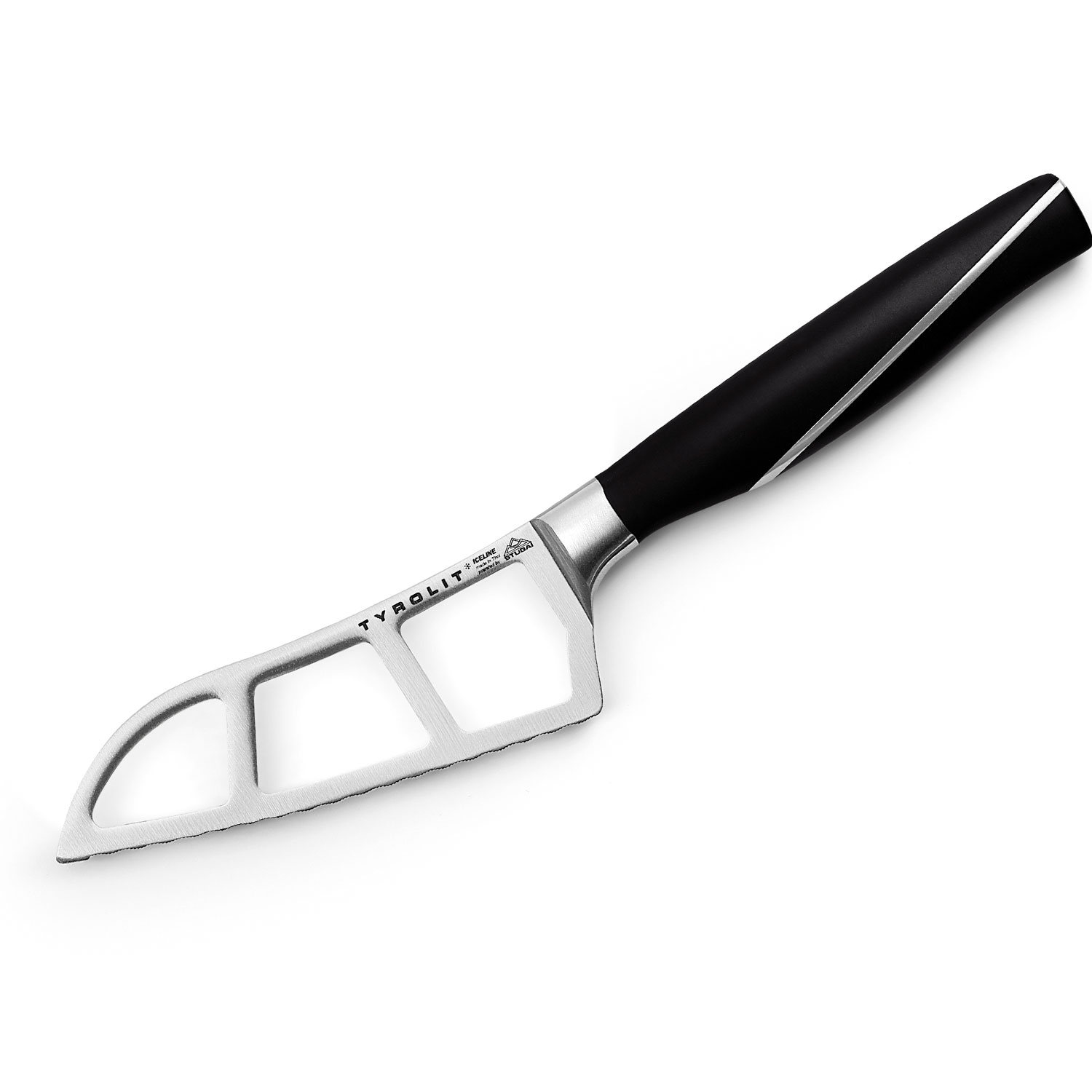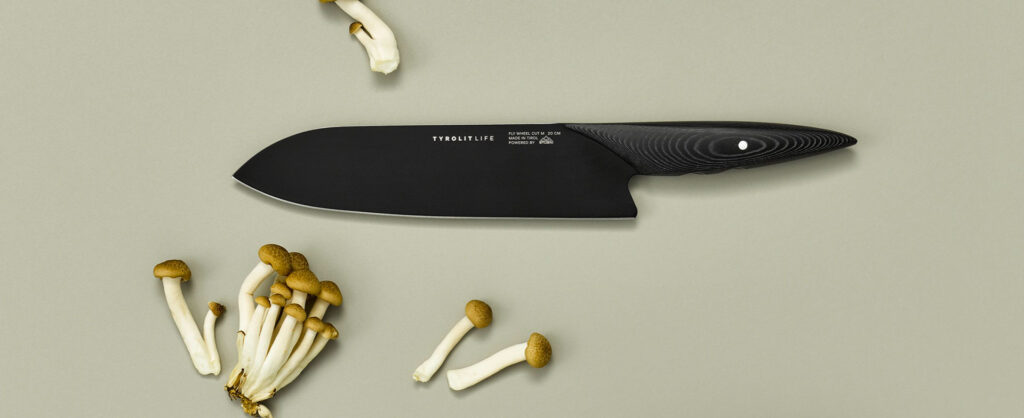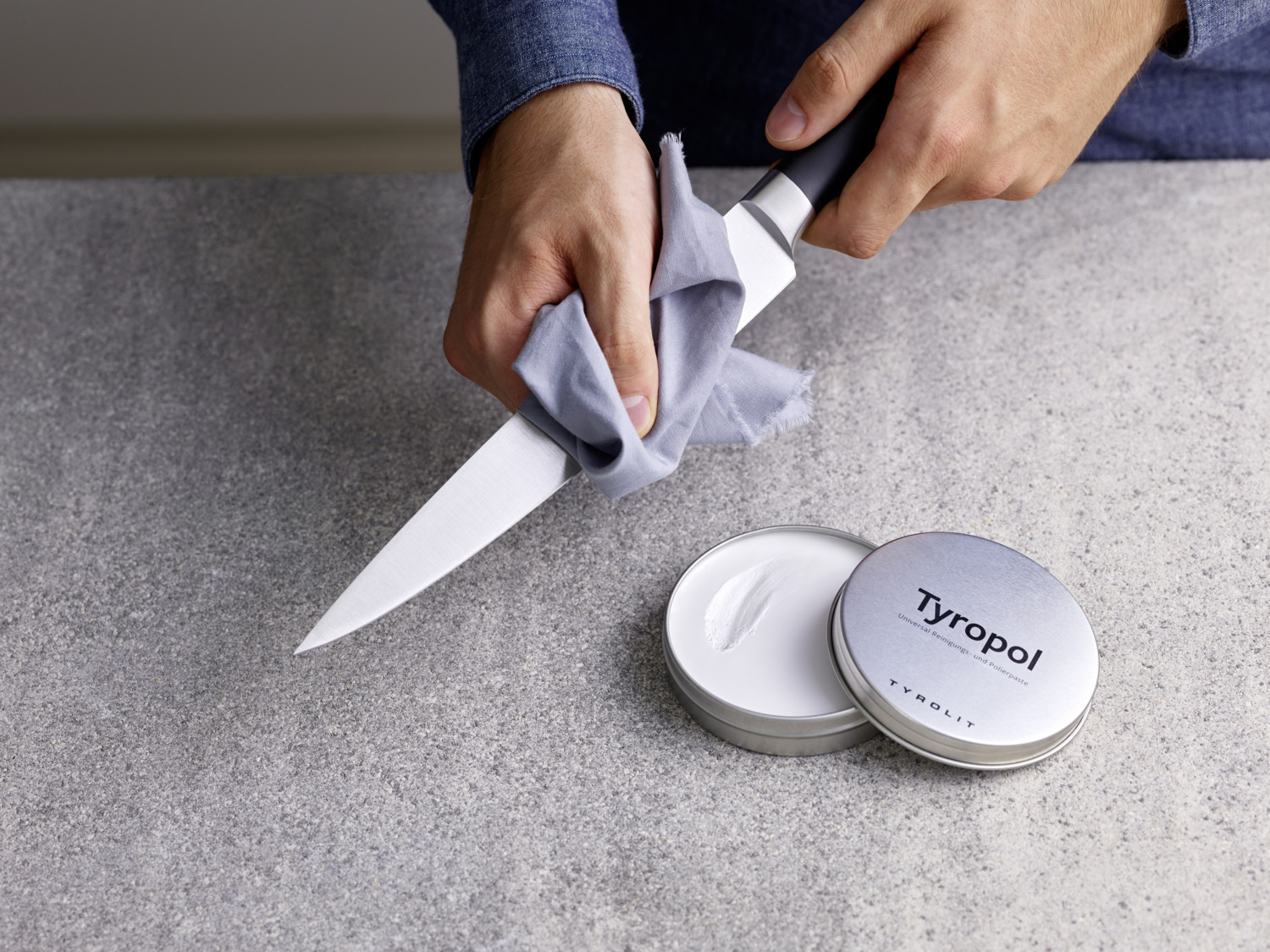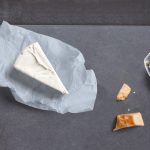Kitchen knives – The best tips and information

Whether beginner, amateur or professional chef – a high-quality kitchen knife is the heart of every kitchen. After all, what could be more daunting than having to work with a blunt knife every day?
A sharp kitchen knife, on the other hand, is a real pleasure. When the knife blade glides easily and effortlessly through the tomato, it’s a great feeling.
If you’re at the start of your culinary journey and in search of the perfect basic set of kitchen knives, you’ll discover what constitutes a high-quality kitchen knife with a sharp blade and how to maintain sharp kitchen knives for a lifetime.
One thing is certain: a high-quality kitchen knife can last a lifetime if it’s treated correctly. This involves proper maintenance, appropriate storage, and regular sharpening. Learn how to sharpen your kitchen knife’s blade regularly and how to store your knife set in a way that protects the blades.
From bread knives to vegetable knives to the santoku knife and the indispensable chef’s knife: in this article, we dive deep into the world of kitchen knives.
What is a kitchen knife?
A kitchen knife is, in its simplest definition, a tool specifically designed for cutting, chopping, slicing, peeling, and mincing food in the kitchen. However, a kitchen knife is much more than just a basic tool. It is an indispensable kitchen aid that should not be missing in any household.
Kitchen knives come in a variety of shapes and sizes, each designed for a specific application in the kitchen. The more specialized the task, the more specialized the knife tailored for it.
However, what distinguishes all good kitchen knives is the blade. A high-quality knife blade allows food to be cut cleanly and precisely without crushing it or damaging its structure.
There are chef’s knives or carving knives with a blade length of 15 to 30 cm, which are ideal for slicing meat. The classic chef’s knife typically has a blade length of 15 to 25 cm, while other kitchen knives with only an 8 cm blade length are perfectly suited for vegetable cutting – such as paring knives or vegetable knives. Fillet knives, on the other hand, feature a very thin and flexible blade ranging from 15 to 25 cm, designed specifically for filleting fish and meat.
A sharp knife is not only more efficient, it is also safer to use. Because a blunt knife can slip and cause injury, while a sharp knife allows precise cuts and reduces the risk of accidents.
In addition to the sharp blade, the production, the handle and ergonomics as well as the weight are important factors that you should consider when choosing a kitchen knife.
A high-quality kitchen knife significantly enhances the culinary preparation experience. Holding the right knife makes you feel more secure, allows for quicker work, and the final dish is pleasing both in taste and appearance. It simply adds joy to the cutting process
Therefore, it is essential to be familiar with the various types of kitchen knives and to choose the appropriate knife for each specific task. This also simplifies the selection of your basic kitchen knife set.
How is a kitchen knife constructed?
A kitchen knife may seem simple at first glance, but in reality it is an interplay of precisely designed and well thought-out components. Each part of a kitchen knife fulfills a specific function and contributes to the overall performance.
Knife blade
The essential component of any knife is undoubtedly its blade, often also referred to as the cutting edge. Its quality is the key to the entire knife’s performance
Blade length and shape play a central role here, as they vary depending on the area of application. While the length significantly influences the handling, the shape primarily determines the special purpose of the knife.
In the realm of materials, high-quality knives commonly utilize stainless steel or the particularly aesthetically pleasing Damascus steel. Ceramic represents another option: it offers remarkable sharpness but is significantly more brittle. Additionally, sharpening blades made of ceramic and Damascus steel is considerably more challenging.
Some manufacturers also rely on high-end stainless chrome steel, which offers enormous hardness thanks to special alloy additives. In addition, this results in special non-stick properties that make it easier to work with such knives.
Another indicator of the quality of a kitchen knife is the hardness of the blade, measured in HRC (Rockwell hardness). A higher HRC value indicates a sharper and more durable blade steel, but the susceptibility to fractures also increases with the hardness.
It is good to know that the harder the knife blade, the harder it is to sharpen it. Stainless steel knives have the advantage that you can easily grind and sharpen them yourself.
Knife shapes in and outside the kitchen: What blade shapes are there?
Depending on the intended use, there are a wide variety of blade shapes. In this article, we provide an overview of the most important of these.
Knife Handle
For optimal handling, a comfortable and well-balanced grip is essential.
While a wooden handle impresses with its warm and traditional appearance, it also needs more intensive care. In contrast, the plastic handle scores points for durability and easy care.
An interesting alternative is the Micarta handle: as a composite material, it combines the advantages of wood and plastic and is particularly used in premium knives.
Other Components of a Kitchen Knife
In addition to the blade and the handle, there are other essential components of a kitchen knife.
The Erl, also called the Angel, is the part of the knife embedded in the handle, which often reaches the end of the handle and gives the knife additional stability.
Directly at the transition between the handle and the blade, you will find the bolster – a thickening that serves as a finger rest and simultaneously prevents the hand from slipping
The spine of the knife (the top and dull side of the blade) allows the user to apply suitable pressure, particularly useful for tasks like chopping.
The manufacture of kitchen knives
The manufacture of kitchen knives is an artful craft that has been perfected over the millennia. The history of the knife is truly unique. Today, forged knives made from a single piece of steel are an indicator of quality.
They offer impressive stability and durability compared to the punched knives that are cut from prefabricated steel plates. In addition, kitchen knives forged from one piece of steel remain rust-free.
If you want to distinguish a high-quality from a less high-quality kitchen knife, there are several aspects to consider. Precision during the manufacturing process, a careful selection of first-class materials and flawless workmanship are decisive criteria.
Furthermore, the type of steel used, the hardness of the blade, the sharpening and balance of the knife as well as an ergonomically shaped handle play a role.
A high-quality knife not only convinces with precise and clean cuts, but also with comfortable handling, which makes working in the kitchen a pleasure. In addition, it guarantees a longer service life due to its robust construction.
What is a santoku knife? The Japanese all-rounder of chef’s knives
The Santoku knife is a true kitchen knife all-rounder and an ideal addition to the classic European chef’s knife. Read more!
European vs. Japanese knives – what’s the difference?
In the world of kitchen knives, both European and Japanese knives occupy a firm place. Both have their own traditions and manufacturing techniques that give them unique characteristics.
European knives are often more robust and have a wider blade angle, usually between 20 and 30 degrees. This makes them ideal for a variety of tasks in the kitchen, from rough jobs such as chopping bones to finer tasks.
They are often made of high-quality stainless steel and offer a good balance between sharpness and durability.
Japanese knives, on the other hand, are known for their extremely sharp blades, which often have an angle of only 10 to 15 degrees. This allows for very precise and thin cuts. A prominent feature of many Japanese knives is the Damascus steel (or damask steel) from which they are made.
This steel is distinguished by its unique pattern of folds, which not only adds to its aesthetic appeal but also imparts exceptional hardness and sharpness to the blade.
Another difference is the weight. While European knives tend to be heavier and more solid, Japanese knives are often lighter and allow for quick, precise cuts.
Both knife types have their own advantages, and the choice often depends on the personal preferences of the users and the specific requirements in the kitchen. Some chefs swear by the precision of Japanese blades, while others prefer the versatility and robustness of European knives.
However, it is undeniable that both types bring their own artistry and beauty to the world of kitchen knives.
Types of Kitchen Knives – What Kitchen Knives Are Available?
In the culinary world, the right tool is often just as important as the right recipe. Because choosing the right knife can make the difference in speed, precision and ultimately in the taste of the end product. But with the large number of knife types, you can quickly lose track. Which knife is suitable for which purpose?
Let’s take a look at the most well-known kitchen knives and explore their specific uses:
Chef’s knife
The chef’s knife is truly the all-rounder in the kitchen. Therefore, it is often referred to as a chef’s knife. Thanks to its versatile construction, which includes a wide and often slightly curved long blade, it is perfectly suited for cutting, chopping and shredding almost everything – from vegetables to meat to fish.
Due to the blade shape, the cradle cut is often used, which allows fast and precise cutting. Thanks to its robust construction and the optimal balance between handle and blade, it is often the first knife that professional chefs reach for.
Bread knife
Its specific serrated blade allows it to glide effortlessly through hard crusts while leaving the bread’s soft crumb intact. The bread knife is designed so that it does not crush the bread, but allows clean slices.
Vegetable knife
This handy knife is the perfect companion for processing vegetables in all their forms. Its compact size allows for precise work, making it ideal for cleaning, peeling and finely slicing vegetables and fruits.
Santoku Knife
Originally from Japan, the Santoku knife is similar in function to a chef’s knife. It is distinguished by a wider and shorter blade, often featuring small indentations to minimize the sticking of food – known as the Granton edge.
Utility knife or universal knife
This knife is the Swiss Army Knife of the kitchen. Its medium-sized blade and versatile shape enable a wide range of applications, from preparing vegetables to cutting small pieces of meat.
Filleting knife
Its slender and flexible blade makes filleting fish and meat effortless. It enables clean cuts along the bones and provides perfectly prepared fillets.
Steak Knife
A must-have at every barbecue. Its sharp blade effortlessly cuts through meat without tearing the fibers and squeezing out the juice.
Meat Knife
Elongated and sharp, this knife is ideal for cutting large pieces of meat, be it a Sunday roast or a large piece of beef.
Cheese knife
There are different types of cheese knives depending on the consistency and type of cheese you want to cut. A classic cheese knife has holes in the blade so that soft cheese does not stick. Specialized variants such as the Parmesan knife are suitable for hard cheeses. Cheese knives often have a wavy cut, similar to the bread knife. The prongs at the top are used to pick up and serve pieces of cheese.
Chopping Knife
Its impressive, heavy blade is specifically designed to chop through bone and cartilage or cut through very hard food.
Peeling Knife
With its small, often curved blade, it allows fruit and vegetables to be peeled and shaped precisely.
Tomato knife
The finely serrated blade of this knife ensures that tomatoes can be cut cleanly without crushing them.
Other Special Knives
- Boning Knife
- Carving Knife
- Rocking knife
Kitchen Knife Essentials
In every kitchen, whether professional or amateur chef, there are knives that are considered an indispensable basis. These knives are the foundation of any well-equipped kitchen and make daily cooking immensely easier.
Let's start with the chef's knife. It is the absolute must-have and is often referred to as the "Swiss Army Knife" of the kitchen. With its versatile blade, you can cut meat, chop vegetables and chop herbs. It fits well in the hand and is a reliable partner for almost all cutting work in the kitchen due to its balance and sharpness.
The vegetable knife is another indispensable component. Due to its compact size and precise cutting edge, it is ideal for processing fruits and vegetables cleanly and efficiently. Especially for finer work such as cutting garlic or pitting peppers, it is unbeatable. In addition, the vegetable knife can also be used for peeling work.
Depending on culinary preferences and the diversity of dishes being prepared, additional knives may be sensible. For those who love bread and buns, a serrated bread knife is indispensable. It slices effortlessly through hard crusts without compressing the soft interior.
Meat and fish enthusiasts should invest in a good filleting knife. Its slim and flexible blade allows for elegant maneuvering between meat and bone, or skin and fish flesh.
Each of us has different needs in the kitchen. However, by equipping ourselves with a thoughtfully selected set of kitchen knives, we establish the groundwork for a seamless, safe, and most importantly, joyous cooking experience. It is an investment that pays off in enhanced flavors, time savings, and increased enjoyment in cooking.
Do you like to cook meat dishes? Surprise your guests with a steak knife. It's a nice experience to eat a steak or a crusty roast with a steak knife.
The basics of kitchen knives – what chefs want to know
In the world of culinary arts, kitchen knives are not just simple tools, but faithful companions who can influence every step in the cooking process. An in-depth understanding of these tools is therefore invaluable to all cooks.
Whether you're a beginner or an experienced professional, there are some important aspects that are fundamental after purchasing a kitchen knife: care, sharpening, and storage.
In the following sections, we would like to address these questions.
How can I tell if a knife blade is sharp?
The ability to detect the sharpness of a knife blade is an essential aspect for chefs who strive for efficiency and precision in the kitchen. A clear method to check the sharpness of a knife is to cut through a sheet of paper: a sharp knife should be able to divide it effortlessly and cleanly.
But the real art lies in understanding the qualities that lead to this sharpness. The material of the blade plays a decisive role.
For example, a knife made of high-quality steel retains its sharpness longer than one made of inferior material. The type of fabrication, whether forged or stamped, also affects the initial sharpness and the ability of the knife to preserve it over time.
Last but not least, the degree of hardness, measured in HRC, is an indicator of the durability of the sharpness and precision when cutting.
How do I care for my kitchen knives?
Proper care of kitchen knives is crucial for their longevity and sharpness. The most important thing after use is to care for and clean the knife. The knife should be washed immediately by hand and rubbed dry with a soft cloth. The reason why kitchen knives do not belong in the dishwasher is because the aggressive detergent and high temperatures damage the steel and make the cutting edge blunt faster. In addition, they can easily be damaged by clattering around in the machine.
Knife blocks are ideal for optimal storage. These protect not only the knife blade, but also your fingers from unwanted cuts. A high-quality cutting board, preferably made of wood, also protects the knife edge.
Over time, each blade becomes dull, so you should sharpen regularly to always achieve optimal cutting results. By following these tips, you ensure that the kitchen knives maintain their quality for years to come.
Maintaining and Cleaning Knives – 12 Tips from a Tyrolean Knife Expert!
The first version is clear and accurately translated. Here is the final version: High-quality knives reward careful handling with longevity. Therefore, in this article, we give you 12 useful tips on how to clean and care for your kitchen knives.
How can I sharpen my knife blade myself?
Sharpening knives is crucial for precision in the kitchen. Many chefs use sharpening steel daily to maintain blade sharpness, while sharpening stones are used for more intense sharpening.
The correct grit size and a sharpening angle of 15 degrees ensure optimal sharpness and durability of the blade. The grinding technique and the correct angle are critical for the outcome. European kitchen knives typically feature a sharpening angle of 15 degrees, perfectly balancing precision and sharpness
High-quality knife sharpeners with adjusted sharpening angle and variable grit are an efficient alternative to sharpening stones and ensure excellent sharpening results.
Regular blade care pays off.
How much does a very good kitchen knife cost?
The price range for kitchen knives can vary greatly and depends on various factors. A good kitchen knife can be available from as low as 50 euros, while premium models or handcrafted versions can run into several hundred or even over a thousand euros. Of course, it also always depends on the type of kitchen knife.
The premium kitchen knives from Tyrolit Life start at €50 with the vegetable knife or, at €60 for the small Santoku knife. The large Santoku and the classic chef's knife are priced at €120 each – in the two-piece knife set, it's a total of €150 for both knives. At Tyrolit Life, for example, you can purchase high-quality kitchen knives.
So you get a very good kitchen knife basic equipment, high-quality manufactured in Austria. This investment brings joy to cooking and the knives last a lifetime with proper care.

